
Traditional random number generators (RNGs) are now cryptographically secure and easy to use. So why do Web2 applications need to integrate Chainlink VRF?
Typically, Web2 users must trust that the random outcomes generated by the application, such as card draws, bets, and lottery draws, are truly random. In fact, the random number generation is done in a black box in the backend of the application, so there is no real guarantee of fairness and no way for end users to verify the results. In some cases, service providers are heavily regulated and their RNGs are regularly audited, but end users still have no guarantee that insiders will not manipulate RNG results for personal gain, as they cannot verify the results. Chainlink VRF can effectively solve this problem. End users can ensure that no one manipulates the RNG result from the backend, or knows the random number result in advance.
Chainlink VRFIt has all the functions that the current encrypted security RNG scheme can achieve, and can also provide additional value. Provably secure random numbers will not only bring better assurance to Web2 products in industries as diverse as gaming, marketing, and data analytics, but also unlock entirely new use cases. Chainlink VRF is currently certified by BMM Testlabs, so regulated iGaming applications can use it as a verifiable RNG solution. Businesses can use VRF to increase transparency, develop better products, build brands and differentiate themselves from the competition.
verifiable random numberverifiable random numberfirst level title
The bottleneck of traditional Web2 RNG
secondary title
Bottleneck in Pseudo-Random Number Generator (PRNG)
image description
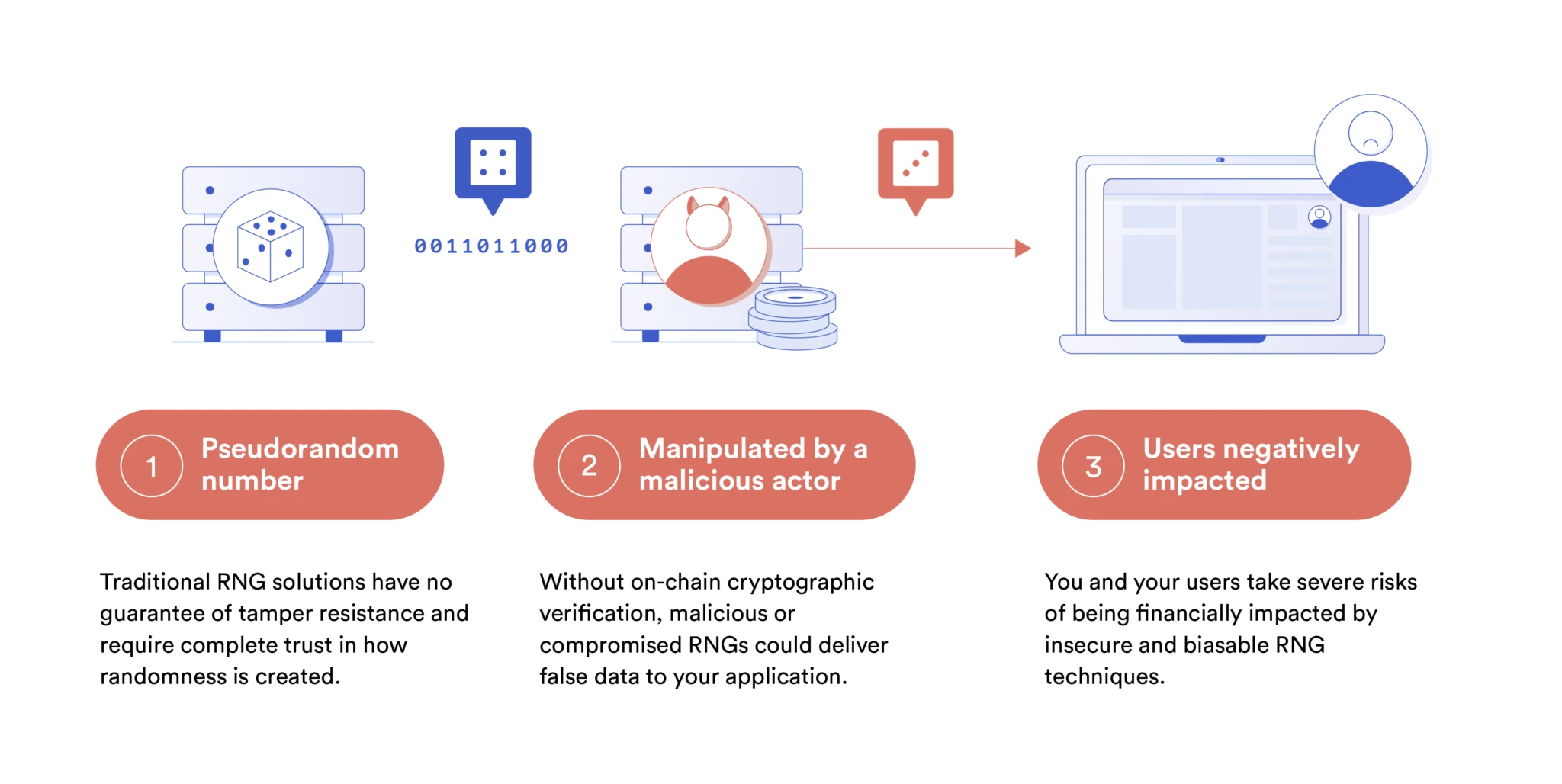
Attackers can reverse engineer PRNGs, making them vulnerable to manipulation and attack.
For example, Kaspersky Password Manager previously released asecurity breach(now fixed), an attacker can exploit the software to crack the stored password. The web version uses Javascripts Math.random() function, which has insufficient entropy to generate secure passwords; while the desktop version uses Mersenne Twister PRNG, which can be used on the marketrandcrackThe tool reverse-engineers its 52 password combinations.
secondary title
Bottlenecks in cryptographically secure PRNGs
The PRNG (CSPRNG for short) that is secured by encryption technology is more robust than ordinary PRNG, because the former will use a seed with a sufficiently high entropy value and a more complex algorithm to generate random numbers, so it is more difficult to predict, and reverse engineering consumes more computing resources. on UNIX operating systems such as Mac and Linux/dev/randomand on WindowsCryptGenRandomThe functions are all mainstream CSPRNGs, which use the entropy value generated by hardware and random system functions as the seed of random numbers. Although CSPRNG can balance security and efficiency, there is a key bottleneck, that is, it cannot be verified. The source of random numbers used in this scheme lacks transparency, so users must trust that the centralized data provider will not manipulate the random number results for personal gain. along withcryptographically secure random numberimage description
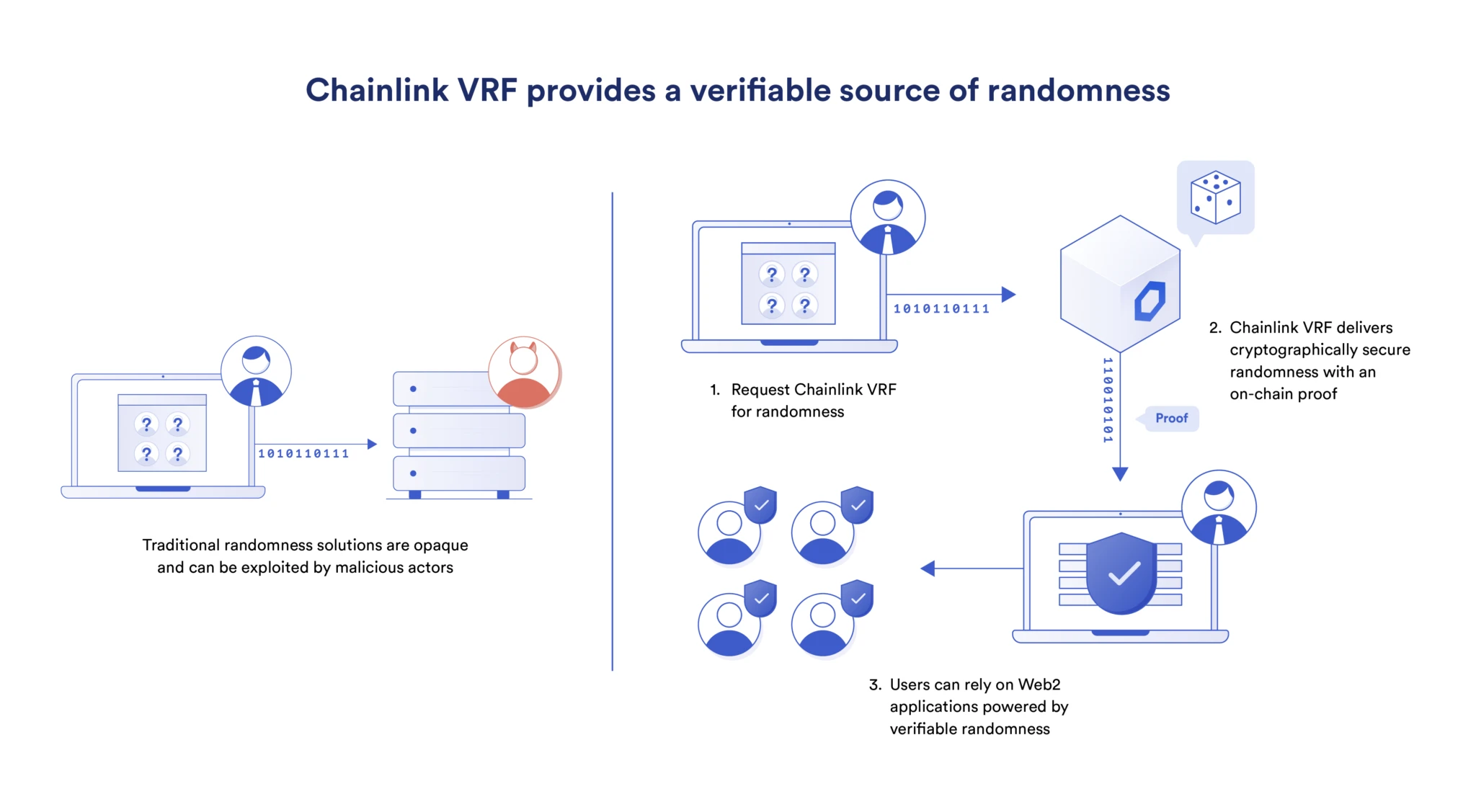
first level title
RNG with verifiable fairness
Web3 is the next development stage of the Internet, adoptingand、smart contractandDecentralized oracle networksecondary title
Chainlink VRF: Secure and verifiable RNG scheme through encryption technology
Chainlink Verifiable Random Function (VRF)image description
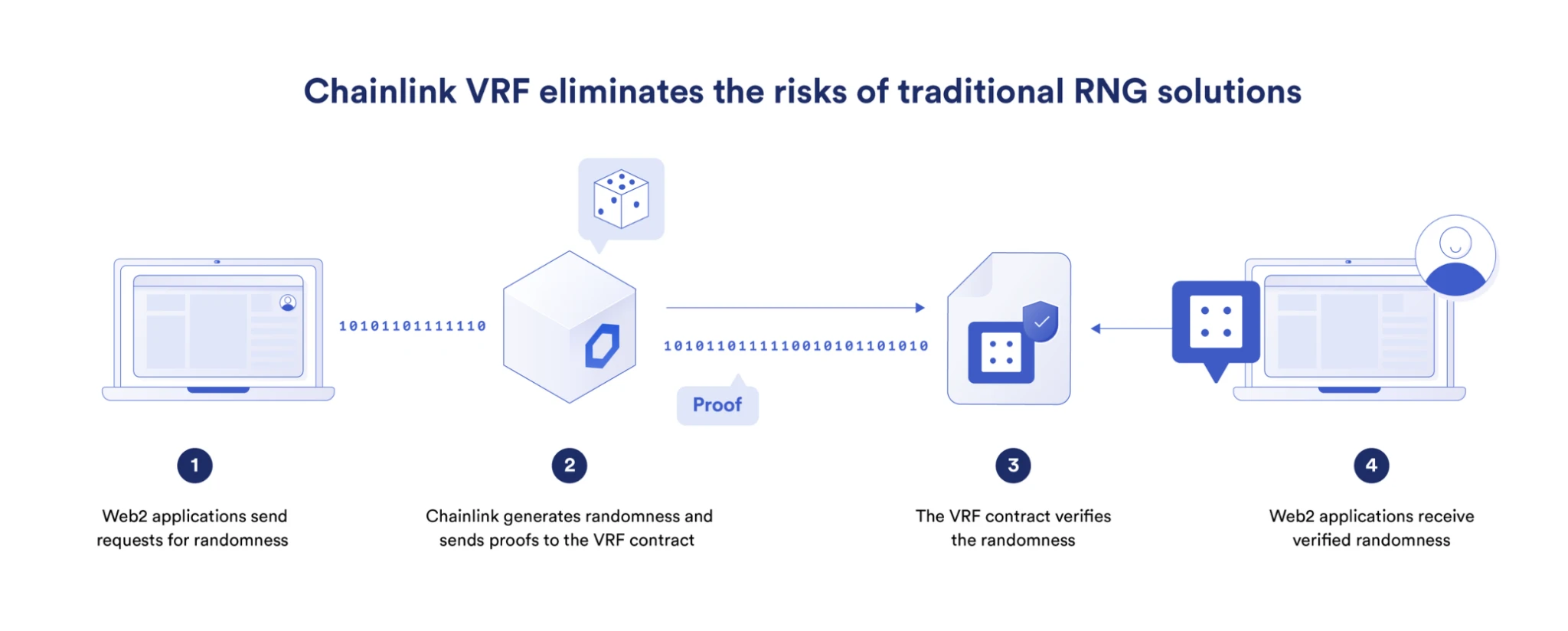
Chainlink VRF generates tamper-proof random numbers, and users can verify the authenticity of the random numbers.
Chainlink VRF is developed by the industry-leading Chainlink network. Chainlink is a decentralized oracle network that provides tamper-proof data input/output and computing resources for applications. When receiving a random number request, Chainlink VRF will combine the unknown block data with the private key previously submitted by the oracle node to generate a random number and an encrypted proof. Applications accept nonces only after verifying that they are cryptographically secure, and their users can independently verify that the source of the nonce has not been tampered with.
secondary title
Verifiability
Verifiability
Users can independently verify the authenticity of Chainlink VRF nonces through cryptographic proofs posted to the chain. That is, users no longer need to trust a centralized entity not to manipulate random numbers.
provably fair
Users can obtain cryptographic proofs to ensure the authenticity of random numbers. That is, an application that receives a random number can provide its users with verifiably fair and unpredictable results.
tamper proof
Attaching a cryptographic proof to the nonce allows applications to verify that the nonce has not been tampered with by any party, including the oracle that generated the nonce.
unpredictability
When a Chainlink VRF request is made, the block data the seed is based on has not yet been created and is therefore unknown. This ensures that the random number cannot be predicted by anyone.
transparency
The code for Chainlink VRF is open source, so both individual users and institutions can view the random number generation process.
seamless integration
Chainlink services can be easily integrated into Web2 applications. Developers only need to adjust some parameters to configure the random number to meet the specific technical requirements of the project.
Compliance certification
Chainlink VRF passBMM Testlabsfirst level title
Use Cases of Chainlink VRF in Web2 Ecosystem
ExampleExampleimage description
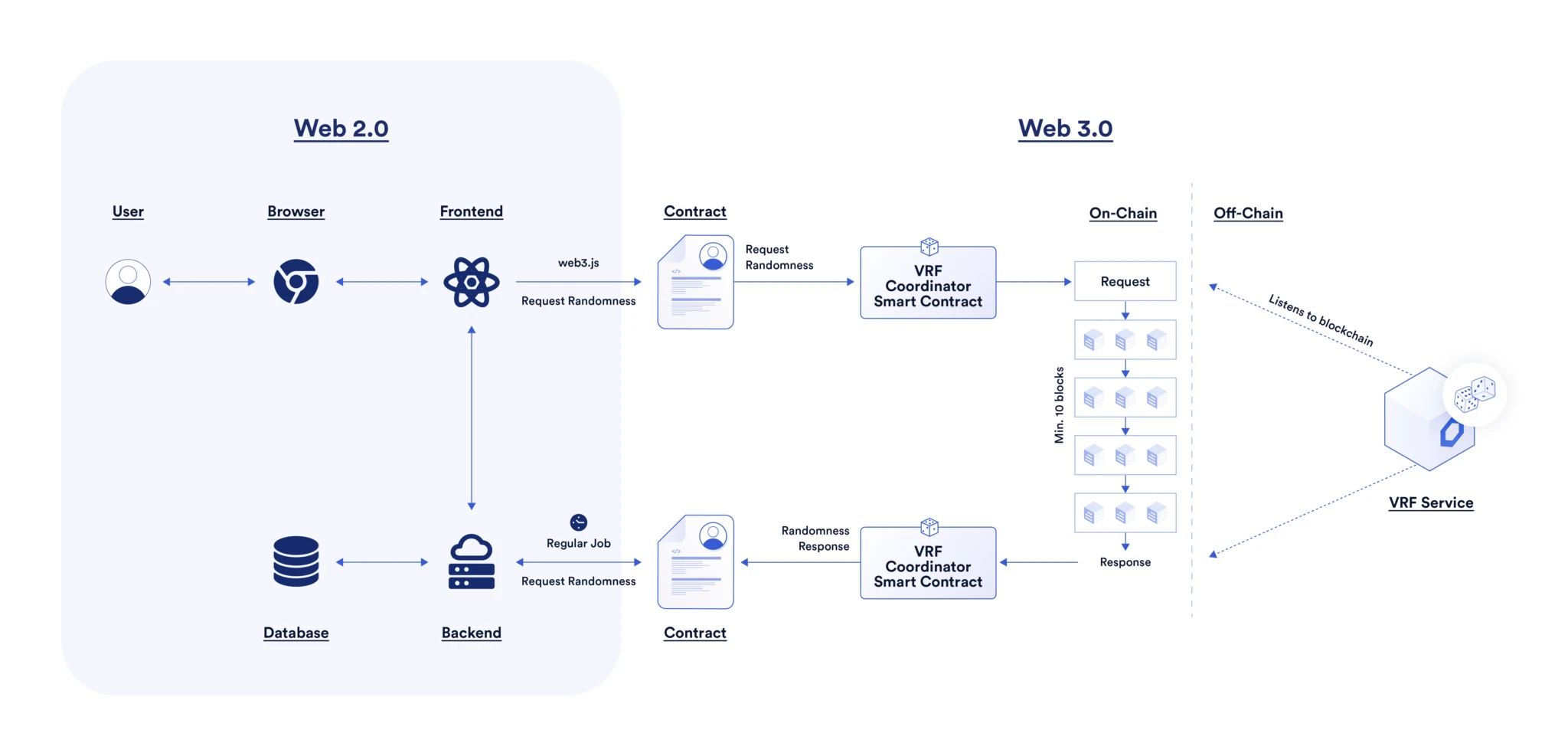
secondary title
online game
Fairness is one of the most critical elements of a good game, and random numbers often affect the results of the game, so online games must have a source of random numbers that can verify fairness.
Provides a verifiable RNG for regulated iGaming applications
Chainlink VRF has obtained the GLI-19 compliance certification issued by BMM Testlabs, a well-known gaming certification agency, so regulated iGaming applications can access Chainlink VRF. Maria Romero, Business Development Manager of BMM Testlabs iGaming, said: BMM is one of the first certification bodies in the blockchain industry, laying the foundation for blockchain game solution development teams to obtain certification through secure and compliant channels in an unprecedented way. .”
Achieving Unpredictable Outcomes in a Fighting Adventure Game
image description
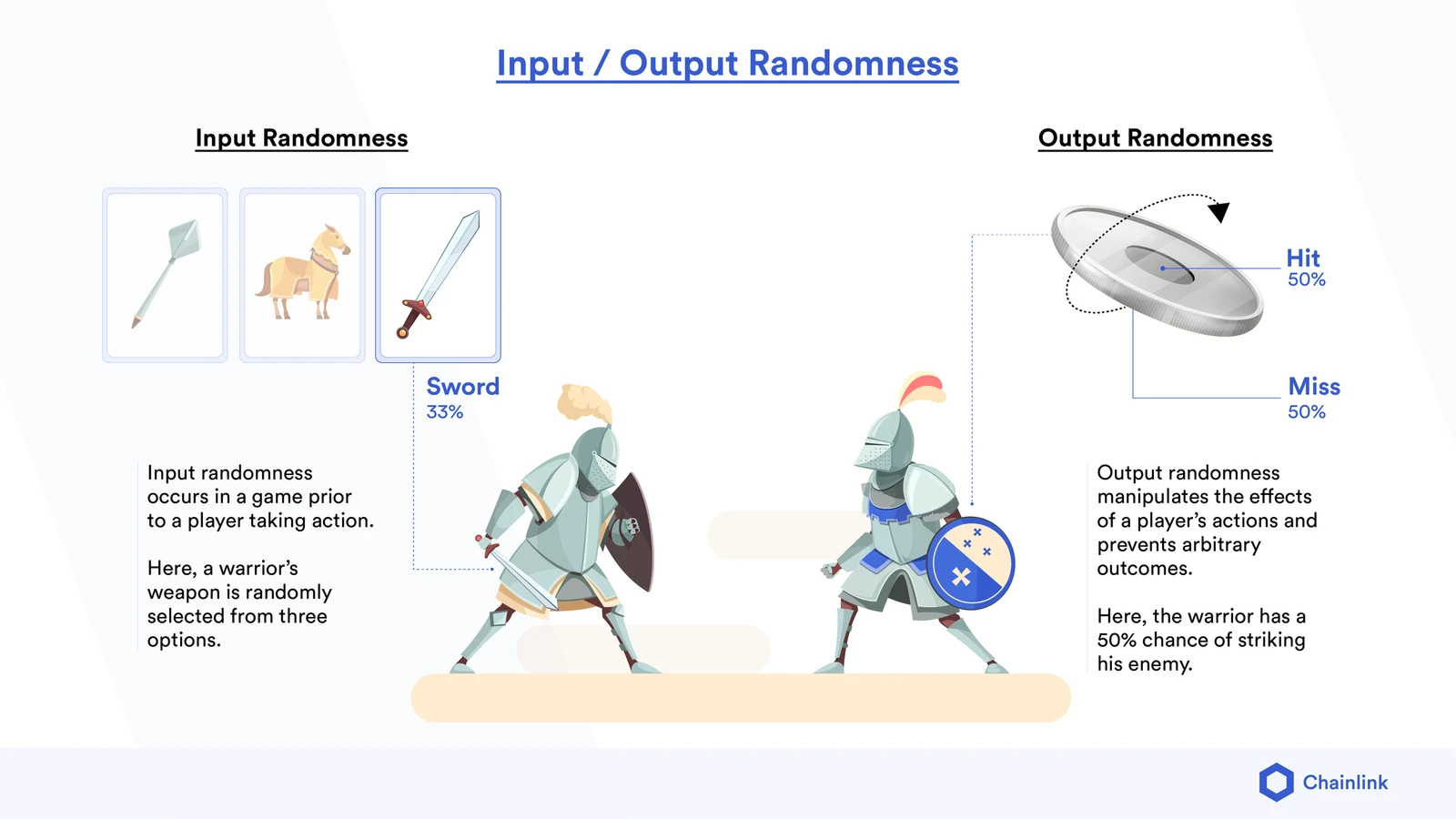
The game can integrate Chainlink VRF to ensure that the attack effect or other game results in the battle game cannot be predicted.
Randomly generate player birthplaces and item drop locations in the Metaverse
There are many interesting settings and easter eggs in the Metaverse. If the players birthplace can be randomly generated, it will greatly improve the game playability. Likewise, if items can be air-dropped to random locations, players can explore all corners of the game map. Some RNG schemes may allow the players birthplace to coincide with the item placement location. And Chainlink VRF can ensure that these locations are randomly dispersed, so that the game can remain playable for a longer period of time.
Match players in PvP battles
Whether its a battle royale game in the metaverse or a first-person racing game with real rewards, the opponents you meet define the course of the race. Use Chainlink VRF to randomly match players so that all players have the same chance of encountering the strongest or worst opponent.
Distribute rare items in treasure chests
Players can open treasure chests to obtain game items such as weapons or potions. Rare items like powerful weapons and limited-edition skins are often in high demand. Therefore, Chainlink VRF can be used to ensure that these items are randomly distributed, and no one can obtain these items unfairly.
Deal cards to players
Card games such as bridge or poker require both luck and skill. Cards can be dealt using Chainlink VRF, and players can verify that the cards they are dealt are random.
pure probability game
secondary title
Marketing activities
Marketers can build brand power, gain market attention and increase market share by making ordinary marketing campaigns stand out. Chainlink VRF can inject innovation and vitality into any marketing activity, and at the same time demonstrate the companys emphasis on fairness and reliability of marketing activities.
Free gift
Random free gifts can be used to acquire new users, increase product usage, and explore feature upgrades. Chainlink VRF can increase the transparency of the entire process, and users can verify the process, ensuring that everyone has a fair chance and that company insiders are not privileged.
for example,SmartCon 20227 lucky participants will be drawn and they will have the chance to sit down with Chainlink co-founder Sergey Nazarov for a Big Mac. SmartCon 2022 uses Chainlink VRF to randomly select winners, which improves the reliability of the entire lottery process and stimulates topic discussions, making this lottery event popular on social media.spread widely。
Innovative Product Features
Companies can use Chainlink VRF to randomly determine product features, such as color, limited-edition customization, or fan design, to drive product attention.
Choose event location
Many conferences, events and festivals have passionate fan bases who want their organizers to host the event in their city. Organizers can use Chainlink VRF to randomly decide an event location for them and show fans that the final location was chosen fairly from a range of suitable venues.
gamification incentives
lottery
lottery
The higher the value of the lottery prize, the more necessary it is for users to ensure the reliability of the lottery process. Chainlink VRF can guarantee that each participant has a fair chance of winning.
Distribute concert tickets fairly
Fans are eager to go to a concert of their favorite artist. Tickets for concerts are often hard to find, and many fans miss the opportunity to buy tickets because they cannot access the Internet when issuing tickets. In this case, a lottery can be used to replace the regular ticketing mechanism. All fans have the opportunity to participate in the lottery, and use Chainlink VRF to distribute tickets fairly.
pick a winner
Some raffle pools have very high prize values, so participants expect the raffle to be absolutely fair. Verifiable random numbers can provide users with cryptographic proof that the source of the random numbers has not been tampered with or manipulated. Ultimately, doing so lends credibility to the sweepstakes and attracts more participants.
The Ape SocietyImprove the reliability of sweepstakes with Chainlink VRF. Although they areWeb3data analysis
data analysis
The seed of Chainlink VRF has a high enough entropy value and adopts a sufficiently complex encryption algorithm to ensure that all random numbers are unpredictable, so it can well meet the requirements of data analysis.random numberauthenticity requirements. Additionally, Chainlink VRF enables anyone to verify the authenticity of random numbers in a dataset.
Unbiased detection of fraud
The financial services and security industries require random screening of data to identify early fraudulent transactions and malicious behavior. The value guaranteed by these systems is enormous, and there is the potential to unfairly target a user. To address this, Chainlink VRF can be used to generate random numbers, improving the reliability of the fraud detection process and showing users how seriously businesses take security.
Provide a seed with high enough entropy for the machine learning algorithm
first level title
Forward-looking Web2 businesses should seize the opportunity
The traditional RNG solution may be sufficient for the current Web2 ecosystem. But compared to Chainlink VRF, their flaws in random number verification are exposed. Chainlink VRF is both cryptographically secure and verifiable.
Imagine that there are two products: Product A hides the source of random numbers in the backend; Product B uses a verifiable fairness and non-tamperable RNG, and publishes encryption certificates to ensure the reliability of random numbers. Which product will the user choose? For some application scenarios that urgently need to ensure transparency, such as games, marketing, lottery and data analysis, Chainlink VRF has obvious competitive advantages over traditional RNG.
After Web2 enterprises integrate Chainlink VRF, they can gain competitive advantages in their respective vertical fields. In the long run, Chainlink VRF has the potential to become a standard random number solution in the Web2 field, which can guarantee transparency for users; in the short term, companies integrating Chainlink VRF will have the opportunity to establish considerable differentiated competitive advantages in their field. In addition to helping businesses build better products, Chainlink VRF can help businesses build their brand around fairness, reliability, and transparency.
Chainlink VRF can immediately access Web3 technology for Web2 enterprises.
If you are a developer and want to quickly connect smart contracts toChainlink VRFdeveloper documentationdeveloper documentationand join us atDiscordhereherecontact us.










